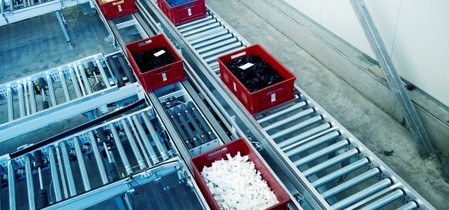6 Key Motor Driven Roller Conveyor Features That Make Setup and Configuration Easy, Flexible
Guest Blog by John Clark, MHI Member viastore systems, Inc.
When it comes to moving products through a facility, sometimes you just need a little more.
When it comes to automated conveyor—while lineshaft, chain and belt driven motor conveyors have historically been the mainstay solutions—over the last several years 24-volt DC motor driven roller (MDR) has been gaining ground.
Ideal for accumulation, 24-volt DC MDR conveyor operates similarly to the other styles of accumulation conveyor, utilizing a photo eye to “see” an item, then triggering its respective section of rollers to stop for accumulation.
The difference between the other conveyor types and MDR is that a select roller (the MDR one) within a section of rollers (called an “accumulation zone”) incorporates an internal 24-volt DC drive which controls the accumulation zone independently of the other zones. These zones can be as short as 1-foot in length. Because the operation of each zone can be turned off and on independently, MDR automation conveyor systems are ideal for accumulating cases, totes or pallets of products.
MDR conveyor offers non-contact accumulation of product, and a lower overall energy use compared to traditional conveyor. But, in a world where all conveyor is increasingly considered a commodity, what separates one 24-volt DC MDR conveyor solution from the others?
The primary differentiator is the ease of setup and configuration of the MDR conveyor. Here are 6 key features to look for in your MDR conveyor that will make your system setup and configuration both easy and flexible. They include:
- Advanced control card technology. The ideal MDR conveyor control card includes built-in accumulation logic for fast, easy setup out-of-the-box, as well as PC-based configuration of motor type, speed, extension and more. Further, its programmability accommodates more complicated operations (including running of two motors or output to other actuators, including solenoids) and the ability to communicate via Ethernet with the facility’s main programmable logic controller (PLC) for receiving commands and diagnostics reporting (such as current draw and roller temperature).
- Adjustable roller speed. MDR rollers with wide speed ranges (and with adjustable acceleration and deceleration over the network) and substantial start up torque minimize the number of different parts needed—including those installed in applications running a range of conveyor speeds.
- Automatic detection of operation, components. What’s the direction of the motor (and therefore the conveyance)? Are there sensor inputs that need recognition? The ideal MRD conveyor control card detects both the operation of the system as well as any connected sensor type.
- Built-in error management. Obstructions happen. When they do, the ideal MDR conveyor can easily compensate to prevent disaster with built-in jam detection, arrival timeouts and auto-resets for both.
- Versatile design and construction. The conveyor platform housing the rollers should feature simple design and construction with reliable, cost-effective, snap-in components to ensure that it is easy to install and maintain. It should also include easy-to-integrate straights, curves, spurs, transfers, diverts and other special components.
- Unlimited installation options. If needed, the MDR conveyor integrator should be able to customize the equipment with unique between-frame widths, lengths, roll centers, zone lengths, speeds, and options like poly-v driven rollers, cold temperature components, sleeved rollers, belted zones, sensors, custom paint colors, special guardrail, frame modifications and more.





